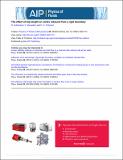Files in this item
The effect of slip length on vortex rebound from a rigid boundary
Item metadata
| dc.contributor.author | Sutherland, D. | |
| dc.contributor.author | Macaskill, C. | |
| dc.contributor.author | Dritschel, D.G. | |
| dc.date.accessioned | 2014-08-25T15:31:04Z | |
| dc.date.available | 2014-08-25T15:31:04Z | |
| dc.date.issued | 2013-09-23 | |
| dc.identifier | 143238593 | |
| dc.identifier | 345d91b2-3bd8-4a8a-a9b0-19adebe4f74e | |
| dc.identifier | 84885026819 | |
| dc.identifier.citation | Sutherland , D , Macaskill , C & Dritschel , D G 2013 , ' The effect of slip length on vortex rebound from a rigid boundary ' , Physics of Fluids , vol. 25 , no. 9 , 093104 . https://doi.org/10.1063/1.4821774 | en |
| dc.identifier.issn | 1070-6631 | |
| dc.identifier.other | ORCID: /0000-0001-6489-3395/work/64697799 | |
| dc.identifier.uri | https://hdl.handle.net/10023/5232 | |
| dc.description.abstract | The problem of a dipole incident normally on a rigid boundary, for moderate to large Reynolds numbers, has recently been treated numerically using a volume penalisation method by Nguyen van yen, Farge, and Schneider [Phys. Rev. Lett.106, 184502 (2011)]. Their results indicate that energy dissipating structures persist in the inviscid limit. They found that the use of penalisation methods intrinsically introduces some slip at the boundary wall, where the slip approaches zero as the Reynolds number goes to infinity, so reducing to the no-slip case in this limit. We study the same problem, for both no-slip and partial slip cases, using compact differences on a Chebyshev grid in the direction normal to the wall and Fourier methods in the direction along the wall. We find that for the no-slip case there is no indication of the persistence of energy dissipating structures in the limit as viscosity approaches zero and that this also holds for any fixed slip length. However, when the slip length is taken to vary inversely with Reynolds number then the results of Nguyen van yen et al. are regained. It therefore appears that the prediction that energy dissipating structures persist in the inviscid limit follows from the two limits of wall slip length going to zero, and viscosity going to zero, not being treated independently in their use of the volume penalisation method. | |
| dc.format.extent | 22 | |
| dc.format.extent | 1213203 | |
| dc.language.iso | eng | |
| dc.relation.ispartof | Physics of Fluids | en |
| dc.rights | © 2013 AIP Publishing LLC | en |
| dc.subject | QC Physics | en |
| dc.subject.lcc | QC | en |
| dc.title | The effect of slip length on vortex rebound from a rigid boundary | en |
| dc.type | Journal article | en |
| dc.contributor.institution | University of St Andrews.University of St Andrews | en |
| dc.contributor.institution | University of St Andrews.Pure Mathematics | en |
| dc.contributor.institution | University of St Andrews.Applied Mathematics | en |
| dc.contributor.institution | University of St Andrews.Marine Alliance for Science & Technology Scotland | en |
| dc.contributor.institution | University of St Andrews.Scottish Oceans Institute | en |
| dc.identifier.doi | 10.1063/1.4821774 | |
| dc.description.status | Peer reviewed | en |
| dc.identifier.url | http://www.scopus.com/inward/record.url?eid=2-s2.0-84885026819&partnerID=8YFLogxK | en |
This item appears in the following Collection(s)
Items in the St Andrews Research Repository are protected by copyright, with all rights reserved, unless otherwise indicated.

